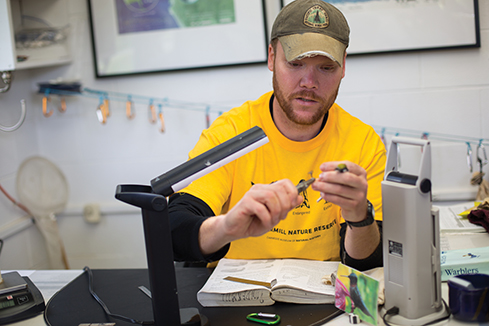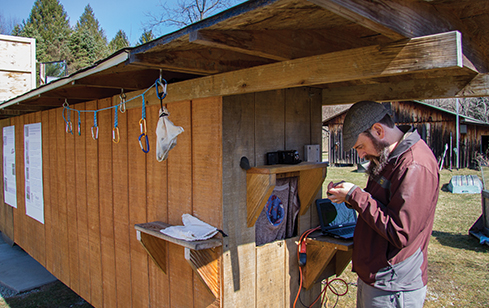 |
|||||||||||||
|
Saving the Songbird
Saving birds from glass collisions is more than a noble pursuit. It’s an important area of study led by the avian-research team at Powdermill Nature Reserve. On most spring mornings, Luke DeGroote gets up before dawn to study whether a dark-eyed junco, tufted titmouse, and assorted other birds will fly through a 25-foot tunnel without crashing into glass. But relax: No birds are harmed during this scientific experiment at Powdermill Nature Reserve, the environmental research center of Carnegie Museum of Natural History.
Most people have witnessed a bird collide into a window of their home or found one crumpled below an office building. But few understand the magnitude of the carnage: An estimated 365 million to 988 million birds die each year striking windows in the United States alone. “It’s staggering,” says DeGroote, birdbanding coordinator at Powdermill, which is nestled on 2,200 pristine acres in the Laurel Highlands. Most birds have eyes on the sides of their heads and can sense predators lurking behind them, but they have poor depth perception, making it hard for them to see windows until it’s too late. “A bird flying through the air is like a kid on a skateboard who is texting and not paying attention to where they’re going,” says Christine Sheppard, bird collisions campaign manager for the American Bird Conservancy. “Then suddenly—bam! They hit something. “People think we see glass, but we can’t. What we see is dirt on the glass. When someone puts a sticker on a window, people know there is glass. But birds see it as something to fly above or below.”
SEEING LIKE BIRDSThe biggest risk for window strikes is during spring and fall migrations, when birds fly 100 to 200 miles overnight, only to land famished and exhausted. Songbirds— thrushes, warblers, and sparrows—are the most susceptible. “Most collisions happen at dawn,” DeGroote says. “Birds are focused on trying to eat, they see reflections of the landscape—trees, sky, clouds—in windows and often fly into the glass.” DeGroote runs the tunnel during these high-volume periods, when birds are most plentiful at the reserve’s longstanding birdbanding station. (The Powdermill team catches, bands, and releases between 2,000 and 2,500 birds in April and May alone.) Sheppard was the first to run the experimental tunnel, which was built in 2009. Today the research is supported by the Colcom Foundation and the glass manufacturers whose products are tested. One of only three in the world, the tunnel is based on a prototype built in Austria. It’s a strange-looking contraption. At one end of a darkened cavern are two panes of glass—a control glass, which is clear, and a test glass, with lines painted on the inside. The idea is to see if the bird will avoid the patterned glass made of a material that reflects ultraviolet light. Presumably, they see the pattern as something solid while the human eye can barely make it out. Glass manufacturers pay researchers at Powdermill to test glass and rate its birdfriendliness on a scale of 50 to 100. Buildings with bird-friendly windows can use this score as one qualification for the increasingly sought-after LEED certification, the recognized standard for measuring building sustainability. This process has increased the demand for testing at Powdermill, with six companies currently participating. A morning with DeGroote shows how labor-intensive it is to figure out what a fluttering bird sees. A half an hour before dawn on a recent spring day, he and Mary Shidel, bird-banding assistant, set up mist nets on the bucolic grounds. They hike to the accompaniment of song sparrow trills and Canada Geese squawks. Within an hour, the researchers scoop up sparrows, a cardinal, and a tufted titmouse from the mist net. The tufted titmouse squawks as DeGroote deposits him into a cloth drawstring bag. “It’s the original angry bird,” he quips about the notoriously feisty bird. Once in the lab, the bander identifies the bird species, slips a tiny aluminum cuff bearing a nine-digit identification number on its leg, and then records information about its age, sex, wing length, fat deposits, and body mass, all within about a minute. Powdermill’s avian research program, which helps scientists monitor migration patterns and how avian populations are generally faring in the wild, was established 54 years ago, making it the longest continuous birdbanding station in the country. DeGroote hands ornithologist Matthew Webb, the tunnel operator, a bag with a newly-banded song sparrow. Webb starts a video camera before gently releasing the tiny bird into the darkened tunnel and waiting for it to fly toward the light at the exit. But the bird doesn’t budge. Webb releases it back into the world. The next bird, another sparrow, flies on cue, hitting the net on the left side before soaring out the opposite side and into the morning air. In this test run, they don’t install the glass panes because they’re researching whether the birds see the netting against a painted background of clouds on sky. “He didn’t seem to see the net,” Webb reports. By itself, this few-second run doesn’t mean much. But they will repeat this particular experiment 100 times.
In the coming weeks, the duo installs 10 panes of glass of various patterns and reflective coatings, some with vertical stripes and dots and others with more random patterns. Webb reviews each flight on the video camera, frame by frame. They collect 80 flight runs and then assign a score based on the percentage of times a bird avoids the test glass and flies toward the clear glass. Each pane receives a percentage score of bird-friendliness. Arnold Glas, a regular tester at Powdermill, advertises its Ornilux Bird Protection Glass as a “UV-patterned glass that is visible to birds but virtually transparent to the human eye.” So the option of bird-safe glass does in fact exist, and slowly new products are coming onto the market. But not everyone in the construction industry is concerned about saving birds, especially when it means higher costs and limited aesthetic options. “A bird flying through the air is like a kid on a skateboard who is texting and not paying attention to where they’re going. Then suddenly—bam! They hit something.”
- Christine Sheppard, Bird Collisions Campaign Manager for the American Bird Conservancy“What we want is to create the situation where builders and architects have maximum flexibility, and they don't feel like bird-friendly design is a burden,” says Sheppard. “We're not trying to get them to stop using glass, and we're not trying to make them design ugly buildings; we want to give them lots of different possibilities. To do that, we have to ask these birds a lot of different questions.” BEING A SOLUTIONBird advocates in some cities regularly walk the streets to perform body counts on dead birds in order to identify which buildings kill birds and which ones are safe. Each morning from 5:30 to 7:30 a.m., a group of volunteers from BirdSafe Pittsburgh—a partnership between eight local conservation organizations, including Carnegie Museum of Natural History and The National Aviary, coupled with citizen scientists—walk a designated route on Downtown streets. While business people with suitcases stride purposefully to their offices, BirdSafe Pittsburgh volunteers look down, scoop up, and bag dead and injured birds, and mark the location of the collision. Birds that collide into buildings usually die of internal bleeding, not a snapped neck as is commonly assumed, DeGroote says. They donate the dead birds to the Museum of Natural History. They take the injured ones to Animal Rescue League & Wildlife Center in Verona, where the birds are fed and rested. “We want to work with building operators to identify problem features and then collaborate on solutions.”
- Matthew Webb, Ornithologist, Founder of BirdSafe Pittsburgh“It takes real dedication from our volunteers,” says Webb, who founded BirdSafe Pittsburgh a year ago. “We want to work with building operators to identify problem features and then collaborate on solutions.” Other cities, including San Francisco, New York, Toronto, Chicago, and the state of Minnesota have adopted bird-friendly guidelines that mandate ways to build and retrofit a building to make it less lethal to birds. The regulations also spell out birdfriendly landscaping, something DeGroote studies at Powdermill. “If you have the landscaping further away from the building, you won’t attract the birds toward the glass and they won’t be reflected in the glass,” he says. Controversy over glass that is deadly for birds has dogged the Minnesota Vikings’ new $1 billion stadium, which has large clear glass windows. Environmentalists have called for the NFL team to replace the windows with bird-friendly etched glass, but the Minnesota Sports Facilities Authority has said it would cost too much, with $1 million in replacement glass plus exhorbitant delay costs. “If buildings are designed with birdfriendly glass in mind, it’s possible to stay within budget,” notes Sheppard. “But retrofitting is expensive.” In Canada, an environmental group sued a developer for an unusually high number of bird window strikes at a skyscraper complex with mirrored glass windows in Toronto. Though the environmental group didn’t win the suit, the builders agreed to retrofit the towers with an outer-layer film designed to steer birds away, and the high-profile trial drew attention to the issue.
But contrary to popular belief, skyscrapers don’t do most of the damage. In his 2014 study, Scott R. Loss, assistant professor of global change ecology and management at Oklahoma State University, discovered that less than 1 percent of all birds die by hitting skyscrapers. Office buildings four to 11 stories tall accounted for 56 percent of bird window deaths (most occur on the lowest two stories), while 44 percent of them died flying into residential windows. New construction trends are not helping to curb the problem. The big, undivided windows in residential great rooms are particularly bad for birds. So is the trend of installing glass rails and glass sound barriers in residential yards. “People put this stuff up and they don’t know they are killing birds,” Sheppard says. “They don’t have the money to fix it.” In public talks, Sheppard, an impassioned advocate, shows a photo of a hummingbird and tells the crowd they don’t want to kill such a beautiful and delicate creature. For those unmoved by that appeal, she points out how birds are a common societal symbol of freedom and peace. They also eat insects that cause West Nile Virus, encephalitis, and malaria. There’s also a big economic incentive to saving birds: catering to the 32 million self-described bird watchers who spend billions of dollars every year on birding paraphernalia, travel, and birdseed. Unlike other conservation issues, people can do something to help. “Usually you go to the zoo and look at the gorgeous, threatened elephant and there is nothing you can do but maybe write a check,” says Sheppard. “But with collisions, your average person can do something.” For the individual homeowner, solutions range from bird-friendly glass, which can cost up to 15 percent more than regular glass; to installing motorized, external, solarpowered window shades; applying solar shades with suction cups; and painting decorations on your windows with your child during high-traffic seasons.
“Tempera paint costs pennies,” she says. One of the most practical solutions: installing screens on the outside of windows, eliminating reflections. “The birds bounce off of them,” Sheppard notes. Advocates like Sheppard and DeGroote say they don’t expect homeowners to run out and buy new windows, but hope when it’s time to replace windows, homeowners will consider being bird-safe. Other simple solutions: applying special tape or barely visible netting or parachute chording in vertical strands, spaced four inches apart. The American Bird Conservancy, located in Washington, D.C., is working with zoos—which welcome more people each year than major league sports—to launch a public awareness campaign about bird-safe glass. They also hope to encourage the public to spread the word by way of social media—to take and post a selfie next to treated windows. DeGroote delivers the same message to visitors at Powdermill. When he tells them that, on average, two birds a year die colliding into the windows of a home, the reaction is mixed. Some people treat their windows while others just shrug. “Some people might say, ‘Why should I care about birds when I can look out my windows for 365 days a year?’ But that’s 100 birds if you own the house for 50 years,” he says. “If you multiply that by 130 million houses, that’s 13 billion birds over 50 years. That’s significant. And it doesn’t have to happen.”
|
|||||||||||||
Before They Were Famous · Visually Telling · Cosmic Bling · Special Section: A Tribute to Our Donors · President's Note · NewsWorthy · Face Time: Cecile Shellman · Artistic License: Born to Paint · Science & Nature: Making It Count · Travel Log · The Big Picture
 |
Copyright © 2017 CARNEGIE Magazine. All rights reserved. |






